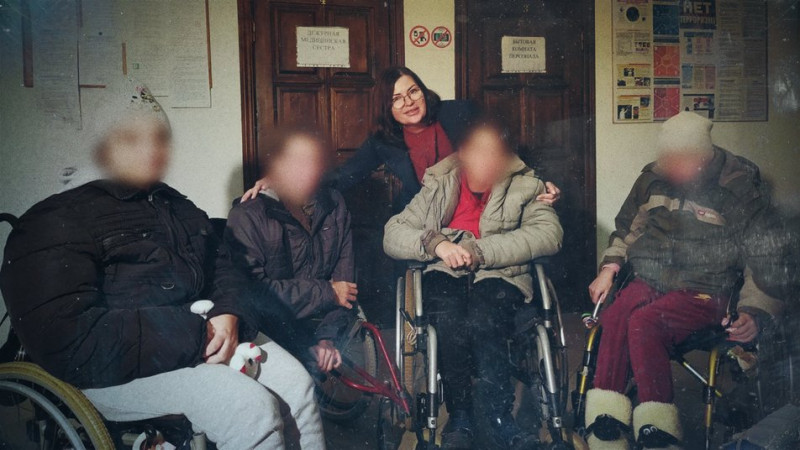
Так звана міністерка праці та соцзахисту окупаційної влади Херсонської області Алла Бархатнова з підопічними Дніпрянського психоневрологічного будинку-інтернату. У листопаді 2023 року їх відправили у пансіон у Пензі. Пропагандистське видання “Новий Херсон”
When the Russian army invaded Ukraine in February 2022, 42 mental health institutions in nine regions of Ukraine were occupied by the Russian military. 17 of these facilities were liberated within the first 100 days.
The journalists of the Suspilne investigative editorial office has found out which institutions remain under occupation, what happened to the patients who were there, and why they were not evacuated at the beginning of the full-scale invasion.
Kherson region: occupiers took patients to Crimea
The above figures were provided to the Suspilne investigative journalists by Olena Temchenko, a human rights activist from the NGO “Ukrainian Human Rights Initiatives”.
In response to our request, the National Social Service of Ukraine indicated that “15 mental health facilities remain territorially” under occupation and that as of January 1, 2022, almost three thousand people were staying and receiving social services in these institutions.
We sent inquiries to local military administrations in nine regions to find out more.
The Kherson region military administration reported in response that before the start of the full-scale invasion, one psychiatric hospital and five psychoneurological boarding houses operated in Kherson region.
There were 566 patients in the Kherson regional psychiatric care facility, 395 patients in the Kherson psychoneurological boarding house, 66 – in the Ushkalskyi men’s boarding house, 120 – in the Dniprianskyi boarding house, 330 – in the Kairskyi boarding house, and 33 – in the Oleshkivskyi boarding house.
At the beginning of the invasion, the Kherson regional psychiatric care facility stopped providing scheduled inpatient psychiatric care – only emergency inpatient and outpatient psychiatric and addiction care was provided.
In April 2023, the Suspilne journalists reported that during the occupation, the institution faced a shortage of medicines and the threat of forced removal of patients, the number of whom in the institution’s inpatient unit changed during the occupation. The Kherson region military administration explained this by “patient discharges and new applications to the institution”.
As of November 11, 2022, when Kherson was liberated, there were 407 patients in the facility. During November, 257 of them were evacuated to other regions of Ukraine. In October 2023, another evacuation of patients to other regions took place. Currently, the hospital continues to operate, according to the Kherson region administration, in regular mode.
After the liberation of the right-bank part of Kherson region, 300 patients of the Kherson psychoneurological boarding house were also evacuated to other regions. Nine were taken home by relatives, the Suspilne journalists were informed in response to a request.
However, the Kherson region administration did not indicate that 54 female patients from this mental health facility had allegedly been taken to Crimea by the occupiers in October 2022. This was reported by the Babel publication in December 2022. Their fate is still unknown. On the website of the Prosecutor General’s Office of Ukraine, we found a case against the former head of the facility, Borys Shutikov, for collaborating with the occupiers and deporting patients to Crimea.
The Kherson region administration reported that as of early March, four mental health facilities remained under occupation. These are the Dniprianskyi, Oleshkivskyi, Ushkalskyi, and Kairskyi psychoneurological boarding houses. The occupation authorities changed the management and employees in the institutions, and “evacuated” the patients under the guise of rehabilitation to Crimea and Russia.
The Suspilne investigative journalists have analyzed where exactly people were taken.
In November 2022, more than a hundred patients of the Dniprianskyi mental health facility near Nova Kakhovka were forcibly taken by Russian military personnel to temporarily occupied Crimea. Some were taken to the Russian city of Penza and placed in the “Louis Quarter” social adaptation center, which came under Ukrainian sanctions on November 18, 2023. The deportation was facilitated by the Russian president’s commissioner for children’s rights, Maria Lvova-Belova, for whose arrest the International Criminal Court issued a warrant in 2023 for the illegal transfer of Ukrainian children.
In November 2023, four more patients of this mental health facility were sent “for rehabilitation” to Penza.

Executive director of the Center for social adaptation of the personality “Louis Quarter” Sofia Lvova-Belova (on the left) meets with patients of the Dniprianskyi mental health facility in Penza, Russia. Сторінка “Квартал Луї” у російській соцмережі
Russian records show that the occupiers renamed the Ukrainian institution from “Dniprianskyi” to “Dniprovskyi”. Director Volodymyr Semenov agreed to collaborate with the Russians and headed the mental health facility until October 2023. In July of that year, he told the Russian publication “Tavria.Kherson” that the patients had everything they needed and that volunteers provided great help.
The propaganda story also stated that the mental health facility was housing 70 people, including 31 people from the Oleshkivskyi psychoneurological boarding house, which the occupiers finally closed in February 2024.
Since October 2023, the institution has changed directors four times. In March 2025, Mikhail Chicherin, a businessman from Rostov region, was appointed to the position. It is unknown how many patients currently stay in the institution and what happened to those who were taken away.
In November 2022, the Russians forcibly “evacuated” over 300 patients of the Kairskyi psychoneurological boarding house in the village of Kairy, Hornostaivskyi district. The Russian emergencies ministry reported that people were sent by bus to Crimea and from there by train to Krasnodar and Volgograd regions. In October 2024, the Kairskyi mental health facility stopped its operation.

Inmates of the Kairskyi mental health facility are being taken by the Russians to Krasnodar and Volgograd regions. Скрин з відео “РЕН ТВ” від 11 листопада 2022 року
It is unknown whether the patients of the Ushkalskyi men’s psychoneurological boarding house located in Verkhnorohachytskyi district were taken out. In one of the Telegram channels of the occupation authorities, we found information that in April 2024, “volunteers” brought humanitarian aid there from St. Petersburg. Since January 2025, the occupation head of the facility has been Oleksandr Shebanov, a resident of the village of Ushkalkiv.
In March 2024, the Russian propaganda outlet “TASS” published the news that the Dniprovskyi and Ushkalskyi mental health facilities were having problems with financing. In particular, it was stated that the patients were fed only with food supplied by volunteers, and that the staff were repairing equipment and premises at their own expense.
In response to the Suspilne information request, the Kherson region administration did not mention the Oleshkivskyi boarding school, where children with complex disabilities and various deviations in mental and intellectual development were educated and treated. According to the “Zmina” publication, in November 2022, some children from this boarding school were illegally taken by the occupiers to a psychiatric hospital in the village of Strohonivtsi, Simferopol district in Crimea. The post by Ukraine’s ombudsman Lubinets, published on November 5, 2022, mentioned 12 children aged 9 to 17.
In July 2023, it became known that the occupiers had relocated the Oleshkivskyi boarding school to Skadovsk, Kherson region, and it was headed by the former director of the local driving school “Svitlofor” collaborator Vitalii Suk. At the end of 2024, Suk fell under sanctions imposed by the United Kingdom against those involved in the forced deportation of Ukrainian children. Commenting on the accusations against him, Vitalii Suk told a Russian publication that since the beginning of 2022, the institution has transferred nine children to Ukraine. As of spring 2025, the institution continued to function. In particular, in March 2025, a video was posted on a Russian social network with children from the boarding school asking to finance the institution and build a new playground.

Children of the Oleshkivskyi boarding school in March 2025. Скрин з відео у російській соцмережі
Zaporizhzhia region: evacuation of patients continues
Before the start of the full-scale invasion, three psychiatric hospitals operated in Zaporizhzhia region. They were the Regional clinical institution for psychoneurological care and socially significant diseases, the Berdyansk and Melitopol psychiatric care institutions.
There were also seven psychoneurological boarding houses in the region: Veselivskyi (293 patients), Liubytskyi (134 patients), Liubomyrivskyi (215 patients), Tavriiskyi (410 patients), Preslavskyi (337 patients), Orlovskyi (202 patients), and Mykhailivskyi (259 patients).
The inmates of the Tavriiskyi and Liubytskyi facilities, located in the Orikhivskyi and Novomykolaivskyi districts, were evacuated to safer areas of Zaporizhzhia region and other regions of Ukraine. The institutions themselves were not relocated, but employment relations with the employees were suspended, the Zaporizhzhia region administration reported to the Suspilne in response to the information request.
As of March 19, 2025, there were still 716 people in three boarding houses located near the front line. The Zaporizhzhia region administration discussed their evacuation to safe regions. For example, the Liubomyrivskyi facility in Vilnianskyi district was evacuated to the Boryslav community in Lviv region.
It was not possible to evacuate the patients of the Preslavskyi, Orlovskyi and Mykhailivskyi facilities, as well as patients of the psychiatric hospital in Berdyansk, who fell under occupation in 2022. The Zaporizhzhia region administration explained this by the “suddenness and intensity of the hostilities and the lack of an official “green corridor”.
The Preslavskyi psychoneurological boarding house in the village of Preslav, Prymorskyi district, is still operating. In November 2024, the Russian occupation authorities of Zaporizhzhia region reported that 292 people were staying in the boarding house. The inmates are actively used in the propaganda of Russian values. Before the full-scale invasion, the director of the boarding house was Yevhenii Rupchev. After the occupation, he started collaborating with the Russians. Currently, Rupchev has been informed of suspicion of collaborationist activities.

The inmates of the Preslavskyi mental health facility are cleaning the territory for the 80th anniversary of the “Great Victory”, April 2025. Телеграм-канал Преславського ПНІ
The Orlovskyi psychoneurological boarding house in the village of Orlove, Melitopol district, is also operating. In 2024, the propaganda channel “Za TV” reported that almost 200 people were in the institution. The inmates of the boarding house were used in the story for Russian propaganda: they were forced to say that the Russian Federation helped them more than Ukraine. The director of the facility, Tamara Vereshchahina, agreed to collaborate with the occupiers. In the story, she thanked that “Russia came because they had been waiting for it”, and thanked the head of the Kremlin, Putin, for “not remaining indifferent”.
The Mykhailivskyi psychoneurological boarding house in the village of Pokazne, Mykhailivskyi district, is also operating. A Russian video from 2023 stated that the institution housed 218 inmates. Before the full-scale invasion, the director of the boarding house was Vitalii Ponomarenko. By order of the so-called Zaporizhzhia region governor, Balytskyi, Ponomarenko was expelled from the temporarily occupied territory of Zaporizhzhia region.
The Suspilne investigators told about the forced deportations of Ukrainians by the occupiers in the “Call-sign Batman” investigation.
As of May 2025, the director of the facility was Vladislav Stolyarenko from Krasnodar region of the Russian Federation. In July 2023, he told a propaganda media outlet that due to shelling, the patients were first resettled in other boarding houses in the region, and later returned.

Inmates of the Mykhailivskyi psychoneurological boarding house return to the village of Pokazne after evacuation, July 2023. Скрин з відео у російській соцмережі
In its response to the information request, the Zaporizhzhia region administration did not indicate how many patients were in the Berdyansk and Melitopol psychiatric hospitals that were occupied after the beginning of the full-scale invasion.
The Suspilne investigative journalists managed to talk to the former director of the Berdyansk psychiatric facility, Dmytro Hertsen, who was in Berdyansk during the first month of the full-scale invasion. He said that at that time there were 90 patients in the facility. According to Dmytro Hertsen, all those who were stable were discharged.
“During one month of work under occupation, the facility was not offered to evacuate. Back then, it was very difficult to organize humanitarian corridors to take patients out. Since our facility had been initially built as a military hospital, it had a bomb shelter with an underground entrance. We also built toilets there. We had our own catering unit, food supplies. In the first days of the war, volunteers also brought us dry rations. Medicines had also been purchased. However, there were power outages, there was no gas supply, no heating, so we still had the challenge of keeping the patients warm,” said Dmytro Hertsen.
Realizing that he would be persuaded to collaborate with the occupiers, Dmytro Hertsen decided to leave:
“Once, while I was in the hospital, two men in civilian clothes came to us. It seemed to me that they were some kind of special service or the FSB, because their language was correct to persuade us to cooperate – calm, measured. They asked if we needed food, medicines. I refused their help. Then they came again. I realized that they would persuade us to collaborate in a different way. Therefore, I transferred my authority to one of my deputies and left the city,” said Dmytro Hertsen.
Currently, the hospital in Berdyansk is managed by Alyona Dikhtiar, who was previously the deputy director of the institution. In January 2024, the Security Service of Ukraine department in Zakarpatska region declared Dikhtiar suspicion of high treason committed during martial law. Dikhtiar repeatedly gave interviews to propagandists, did not allow doctors who did not receive Russian passports to work. The suspect also joined the council of chief doctors at the occupation health department.
The Zaporizhzhia regional center for the provision of psychiatric and addiction care in the occupied territories has two branches: in Molochansk and Melitopol. Since the beginning of the full-scale invasion, there has been no contact with these institutions, the Department of Health of the Zaporizhzhia region administration informed Suspilne.
As of February 24, 2022, the branch in Molochansk, according to the Zaporizhzhia region administration, had 30 patients. The occupiers created a branch of the “Regional center for psychiatric and narcological care of the city of Berdyansk” in this Ukrainian institution. In November 2024, the occupation administration posted a photo of the branch and indicated that from 2022, the institution had 67 employees, and the number of patients could reach 50.
Luhansk region: directors of the occupied mental health facilities agreed to collaborate with the Russians
Before the full-scale invasion, three psychiatric hospitals operated in Luhansk region: the Lysychanska and Svatyivska regional psychiatric hospitals, and the Mental Health Center in Siverskodonetsk. According to the Luhansk region health department, at the end of 2021, they were treating 555 people.
After the beginning of the full-scale invasion, all patients at the Mental Health Center were discharged home. At the end of March 2022, 46 patients from the psychiatric hospital in Lysychansk were evacuated.
327 patients from the Svatyivska regional psychiatric hospital could not be evacuated. The Department of Health explained this by the “rapid occupation of the Svatyivskyi district”. The publication “Zmina.info” reported in October 2022 that the Russian occupiers had evicted patients from this hospital and were using its underground premises for military purposes.
There were six psychoneurological boarding houses in Luhansk region: Popasnianskyi (at the beginning of the full-scale invasion, the institution housed 124 patients), Nyzhnianskyi (135 patients), Novoastrakhanskyi (73 patients), Teplivskyi (109 patients), Dmytrivskyi (276 patients), and Starobilskyi (167 patients).
Inmates from the Popasnianskyi and Nyzhnianskyi facilities were evacuated to Chernivtsi and Cherkasy regions.
The Teplivskyi, Dmytrivskyi, Novoastrakhanskyi, and Starobilskyi facilities remained under occupation with 952 inmates.
The Teplivskyi psychoneurological boarding house continues to operate in the temporarily occupied territory of Luhansk region in the village of Tepliv, Stanychno-Luhanskyi district. The institution’s page on the Russian social network contains posts about how its inmates voted in the Russian presidential elections and how they were involved in the “subbotniks”. Until January 2025, the institution was headed by Svitlana Rudenko. She was also the head before the full-scale invasion. Rudenko agreed to collaborate with the Russians and actively promoted Russian propaganda in the institution. Currently, the director of the facility is a Russian native, Marina Borovskaya from Volgograd region.

A patient of the Teplivskyi psychoneurological boarding house votes in the Russian presidential elections in March 2024. Сторінка інтернату у російській соцмережі
In early 2023, the occupation authorities appointed Alexander Bondarev from Volgograd region as acting director of the Dmytrivskyi psychoneurological boarding house in the village of Dmytrivtsi, Novoaidarskyi district, and in March 2025, Lyudmila Vasilik replaced him. She is also from Volgograd region. On the institution’s social media pages, it can be seen that the patients are used to promote Russian propaganda. In particular, Russian military personnel are invited to the institution.
The Novoastrakhanskyi psychoneurological boarding house, located in the village of Nova Astrakhan, Kreminskyi district, continues to operate under occupation. Oleksandr Filenko, who headed the boarding house before the full-scale invasion, remains the director of the institution under occupation. There is no information in open sources about the number of patients remaining in the facility.
Donetsk region: the Ukrainian authorities managed to evacuate all patients
Before the full-scale invasion, three psychiatric hospitals with 935 inpatient beds and four psychoneurological boarding houses operated in Donetsk region. This is stated in the responses to the Suspilne request from the departments of health care and social protection of Donetsk region.
There were psychiatric hospitals in Mariupol, Kramatorsk, and Sloviansk. At the beginning of the full-scale invasion, the building of the psychiatric hospital in Mariupol was damaged, and the institution’s documents and property remained in the occupied territory. However, according to the Donetsk region administration, all three psychiatric hospitals continue to operate. The Mariupol hospital was relocated to Kyiv.
Four boarding houses operated in Donetsk region: the Bakhmutskyi psychoneurological boarding house (as of February 24, 2022, there were 299 patients in the institution), Komyshivskyi (324 patients), Pokrovskyi (474 patients), and Slovianskyi (398 patients).
The Donetsk region administration response states that all patients of boarding houses were evacuated during March-June 2022 to boarding houses in other regions of Ukraine and abroad, in particular to Spain, Latvia, and Italy. The buildings of the Bakhmutskyi and Komyshivskyi facilities, which are now in the temporarily occupied territories, were completely destroyed.
As of March 2025, only one of the four Donetsk psychoneurological boarding houses, Bakhmutskyi, was officially operating. It was relocated to Poltava region, where 100 beds were deployed.
In response to the information request, the region administration officials also noted that during the evacuation, Donetsk region faced the problem of a lack of free places in boarding houses in other regions. The need for inpatient care for residents of the region who require outside help still exists, the region administration added.
“The unlearned lesson of 2014”
To find out why it was not possible to evacuate patients and inmates from psychiatric hospitals and psychoneurological boarding houses at the beginning of the full-scale invasion and why they are still under occupation, the Suspilne investigators turned to human rights activists, the Ombudsman’s Office, the Ministry of Social Policy, the Ministry of Health, and the National Social Service of Ukraine.
As Olena Temchenko, a human rights activist from the NGO “Ukrainian Human Rights Initiatives”, notes, although psychiatric hospitals and psychoneurological boarding houses are municipal, according to the Convention against Torture and Other Cruel, Inhuman or Degrading Treatment or Punishment, it is the government that is responsible for the life and protection of human rights.
The Ministry of Health and the Ministry of Social Policy forwarded our requests to the regional military administrations.
We asked the Office of the Commissioner for Human Rights whether they had the opportunity to verify the observance of the rights of inmates and patients of psychiatric institutions that fell under occupation, whether they recorded violations of these rights, and whether they contacted international organizations to obtain information from the institutions that fell under occupation. We did not receive answers to these questions.
Human rights activist Olena Temchenko, who worked at the Office of the Verkhovna Rada Commissioner for Human Rights before the full-scale invasion, claims that neither the psychiatric hospitals nor other facilities for people with disabilities were ready for evacuation.
According to the human rights activist, every institution, organization, and enterprise should have evacuation plans for patients and inmates. The Department for the implementation of the national preventive mechanism of the Ombudsman’s Office was developing evacuation recommendations since 2014, when some psychiatric hospitals and boarding houses in Donetsk and Luhansk regions found themselves in temporarily uncontrolled territories.
“The plans are monitored by the State Emergency Service, which is subordinate to the Ministry of Internal Affairs. In 2017, the Ministry of Internal Affairs issued an Order on Approval of the Methodology for Planning Evacuation Measures. According to the order, the evacuation plan in the event of a state of emergency should be updated and approved every year and should define what to do and by whom. Unfortunately, evacuation plans in the event of a fire in boarding houses were checked every six months, but no one checked the wartime evacuation plans until 2022. And this was an unlearned lesson from 2014. In the first days of the full-scale invasion, a strong defense line and heroic resistance of the defenders allowed the inmates and patients to be evacuated in Donetsk region. In Luhansk region, some of the boarding houses were occupied. So even in those regions where the country’s leadership expected a Russian offensive, there was no readiness for evacuation,” says Olena Temchenko.
The human rights activist adds that in the first days of the full-scale invasion, some directors of mental health facilities were ready to take people away:
“However, they did not receive any order. People were in despair because they were told that everything was ready, all the algorithms were ready. However, they called and said, “We were told to find ways to evacuate patients on our own”.
We have not found any publicly available documents that had to specifically regulate the evacuation of psychoneurological boarding houses or psychiatric hospitals at the beginning of the full-scale invasion, had to identify responsible persons, routes, priorities, or algorithms.
There were emergency response plans approved by Cabinet of ministers Resolution No. 11 back in 2014, and territorial evacuation plans for the population. But at the time of the invasion, many of these plans, according to human rights activist Olena Temchenko, were outdated, not adapted to the conditions of a full-scale war, or did not provide for evacuation in conditions of shelling, occupation, or loss of control over the territory.
The Cabinet of Ministers resolution, which regulated under martial law the issue of evacuating children and persons residing or enrolled in institutions of various types for 24-hour stay, was adopted only on March 27, 2022. On March 1, 2023, this resolution became invalid. On June 1, 2023, a new resolution appeared – No. 546 “On the temporary relocation (evacuation) of children and persons residing or enrolled in institutions of various types, forms of ownership and subordination for 24-hour stay, and their return”.
No government body that we contacted has ever given us an answer whether the state is going to evacuate patients from psychiatric hospitals and inmates of psychoneurological boarding houses that were occupied at the beginning of the full-scale invasion and are still there, or whether anything is being done in this direction.


















